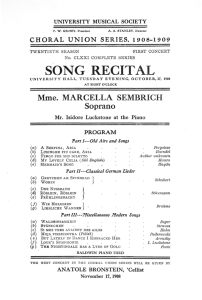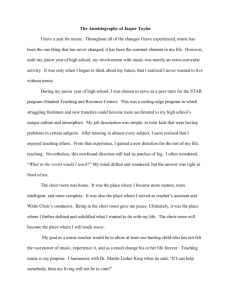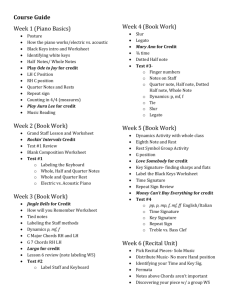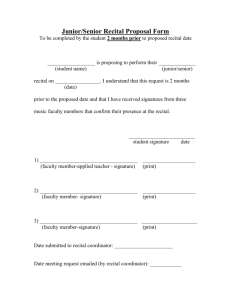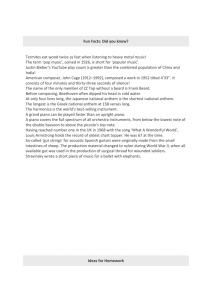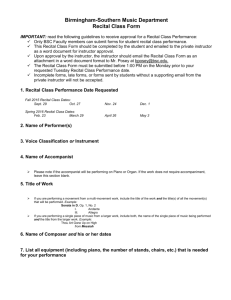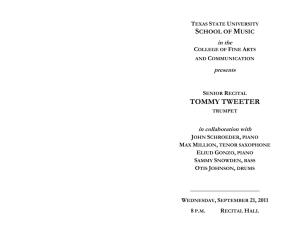Elysia Arntzen's Senior Composition Recital An Honors Thesis (MUSTH 495) by Elysia Arntzen
advertisement
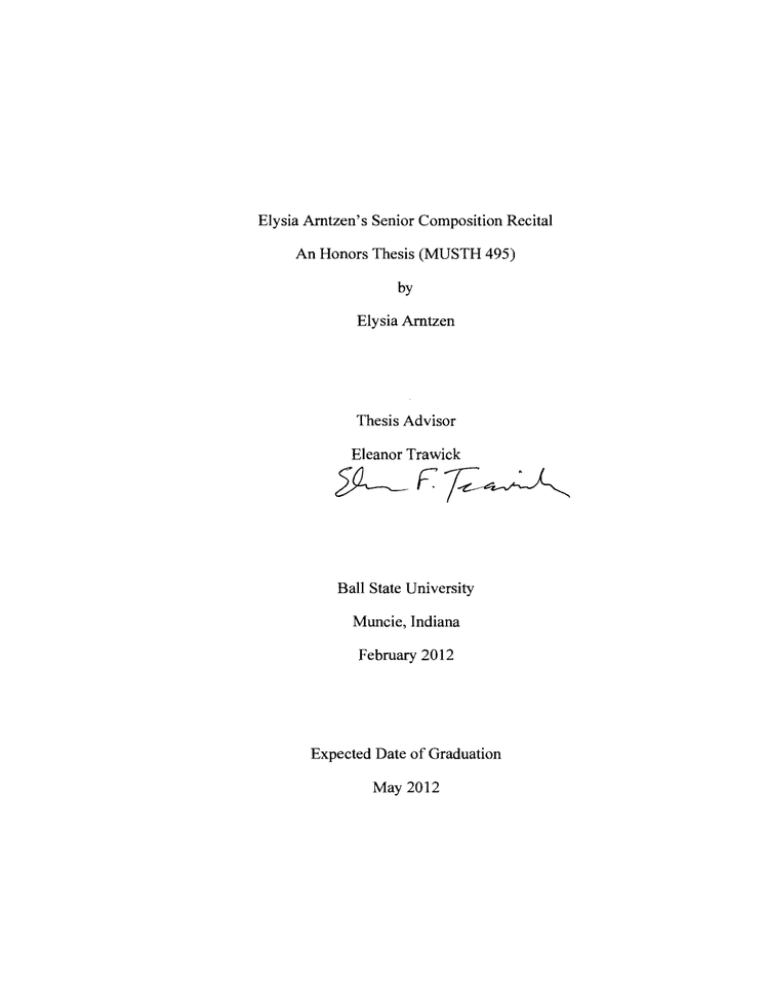
Elysia Arntzen's Senior Composition Recital An Honors Thesis (MUSTH 495) by Elysia Arntzen Thesis Advisor E1eanor Trawick Ball State University Muncie, Indiana February 2012 Expected Date of Graduation May 2012 f " ' ' , ',:l j /:~: r C' 0 I .: ,- ,---. . " • / r-:' f Abstract ,: /" , ,', ,0 ;'l The capstone project for music composition majors is a composition recital of works composed while studying at Ball State. I compiled a variety of works that reflect my growth over the past few years. This reflection covers a brief summary of my studies, explanations of the pieces on my recital, and my opinion on the outcome. Acknowledgements I would like to thank Dr. Eleanor Trawick for helping me put the recital together, Harmony Murphy for rehearsing and conducting the choir, and Nathan Daywalt for playing nearly half the pieces on the program as well as assisting the choir. I began composing as a child around the same time I began taking piano lessons, but I didn't view it as a serious career option until college. I came to Ball State with the intention of getting a music education degree and teaching middle school general music, but after a few years I decided that was not what I really wanted to do. I switched to music composition because I have always enjoyed composing, and theory classes were very interesting to me. Switching to composition allowed me to take composition lessons as well as more advanced theory classes, and opened the door for me to pursue a career composing and teaching at the college level. I am extremely happy with this decision, and it allows me to continue doing what I really love. I have now been in the music composition program for three years. Every teacher I have had has encouraged me to think about composition in a different way. One semester I did a project where I created a very speech-like setting of text to help me compose for voice in a more natural way. Another semester, I worked on creating more interesting and lyrical melodic lines by composing a violin solo. Sometimes I have done exercises that aren't great in themselves, but help me with my current composition project. One of the biggest challenges for me was to not limit myself to what a piano can do when writing for other instruments. My non-piano works have been becoming more idiomatic, although I still have very few works for other instruments. My teachers have often given me recommendations of what to listen to that is relevant to what I am working on. Some of my favorite composers who continue to influence my projects include Copland, Debussy, and Beethoven. In choosing pieces for my recital, I wanted to have a variety of ensembles while showing off some of my stronger works. The first piece on the program was a short fanfare-like horn solo. This one was a more recent work and I consider it to be one of my stronger pieces. Next were a few movements from a wedding suite for string quartet, which I composed a few years ago, 4 along with an arrangement of the English folk tune "Rose Red" for string quartet. After this, I included an electronic piece, a large contrast. Electronic composition is still pretty new to me, and this piece was the first electronic piece of mine I had felt proud of. Next, I wanted to include finished pieces from my most current project, which was a song cycle for baritone solo and piano based on poetry by Edgar Allen Poe. By the time I was putting the program together, I had three pieces completed, which all went on the program. A few of my favorites were two contrasting improvisatory piano solos, which differed from the rest of the program in that I composed them after improvising on the instrument rather than planning it out first. Being a vocalist myself, I enjoy writing for vocalists and setting text, so the second half of my recital was primarily choral works. The first piece after intermission, however, was an electronic piece called "Ice Sprites" which was recently composed for the recital, and is a lighter, sillier piece. In the choral section I included a setting of the "Tomorrow" soliloquy from Shakespeare's Macbeth, a mass generated from the Fibonacci sequence, and finally, to end the recital, an arrangement of "Loch Lomond" for men's voices with snare drum and piccolo. Putting together a choir was not very hard. I asked for volunteers from the concert choir, and a good number of people were interested. I got two good friends to conduct and accompany the choir, and we scheduled regular rehearsals for a month before the performance. The "Fibonacci Mass" was difficult, particularly the first movement. I made sure that I was able to attend the rehearsals with the choir so that I could answer questions and give tips on how to learn certain parts. I also found it necessary to make small changes as I noticed where the choir had problems or where my original notation was unclear. These changes will be put into the revised versions of my scores. Each movement of the mass got easier for the choir to learn, and the later ones took a little less rehearsal time. The other piece that was a little difficult with the choir was 5 "Tomorrow," which was not originally written for a choir. Originally, the piece was written for six singers and was meant to show off individual voices. The first soprano part was extremely high, and I was lucky to have the original singer in the choir, so I made it a solo for the performance. The other parts had 4-5 singers on them, so the challenge was making sure the important lines were still heard in the large group. "Loch Lomond," of course, was a familiar tune and therefore was easy for the singers to learn. The challenge with the piece was a normal one of emphasizing the melody, which was passed around between parts. The words were also unfamiliar to the singers, but they adapted to the new text very well. The non-choral pieces on the program were pretty easy, aside from the baritone solo. The song cycle uses atypical harmonies and the melodic lines are difficult, so rehearsing with both the singer and accompanist is very necessary in order to feel comfortable performing the piece. We were only able to practice together a few times, so it did not get to the level I was hoping for. The rehearsal time we did have was useful, because I was able to explain how the voice and piano parts are supposed to interact. The string quartets used very traditional harmonies and were relatively idiomatic. Those came together in only a few rehearsals. The piano solos were easy, although there were a few spots that I could have notated better and had to demonstrate what I meant. The horn solo was the one thing I did not get to hear rehearsed before the concert. The following program notes were given to the audience at the recital to explain each pIece. Butterflies in the Stomach was written for solo horn in Fall 2011. I wanted to evoke that nervous feeling that most middle schoolers (and some adults) get when they first develop a crush 6 on someone. The longer notes in the piece swell and relax to represent taking a calm, deep breath. These gestures are interrupted by the "butterflies," passages of short notes that jump up and down. The dynamics change frequently and range from piano to fortissimo, just as a person's feelings range from being completely hidden to being worn on their sleeves. To further enhance the jumpy, nervous mood of the piece, I use abrupt meter changes, including a few measures of 7116, and one measure with an added sixteenth note, which throw it off balance. I began writing the Wedding Suite for string quartet in Fall 2010. The first movement that was finished was actually the Ceremony, which is intended for use in a short wedding, followed by the Processional. The two movements that you will hear tonight are the first and the last, both of which I completed this past summer. These use motives from the Ceremony, but are developed in different ways. The Prelude does not include a first violin part, because the performer is to process with the wedding party. This movement alternates between a stately, calm section and a playful, bouncy section. The sudden contrasts are intended to be slightly funny. The Waltz uses both the bridal march motive and the processional motive, which are altered to fit into a rather typical waltz, but would be very recognizable after the Ceremony. These two movements have been chosen because they are pleasant to listen to as standalone pieces. Rose Red is a traditional English tune that I have arranged for string quartet. My former teacher Anthony Amstutz suggested I try composing a piece in one day as an exercise, so I decided to give it a try but writing an arrangement rather than a new piece. Rose Red was written on May 16, 2010, and is a series of variations on the original tune. The piece was edited a little after the fact, mostly to fix notation and a few range problems, as I didn't have much experience 7 writing for strings yet. My main focus in writing Rose Red was to distribute melodic line throughout the parts in order to make it interesting for the players as well as the audience. Migraine is a digital fixed·media piece that I wrote toward the end of Fall 2011. It represents mounting stress that can be caused by the imminence of finals week. The piece begins with a bubbling sound and a calm melody, but suddenly a rhythmic line and noise are introduced and the melody gets more frantic. Next there are shrieking tritones and eventually a throbbing pulse. The piece grows in tension until everything shuts down and the calm bubbling sound returns, signifying freedom. Programs used were Granular Cloud Generator, Cecilia, Tassman, and Kontakt. I got the idea to write To Whom while reading through some poetry by Edgar Allen Poe and noticing that a number of poems were titled To "blank" or "initials" rather than a name. I selected six of these poems for a song cycle. The three selected for this performance are songs 2, 5, and 6 from the cycle. The song #2. ML.S····· compares the subject of the poem with an angel and feels very worshipful. My setting of this is meant to resemble a hymn, although the chords I have chosen are not typical of an actual hymn. The accompaniment starts with chords that complement the vocal line, but occasionally it breaks away from this pattern. #5. To .......... describes the narrator's sudden inability to express his feelings with adequate words. I use whole·tone scales and various tonal centers before ending in C. The next piece, #6. To O···D, is to be performed with #5 and is to be attacca. It is pentatonic, but the tonal center moves. The piano part echoes the rhythm of the vocal part and adds in "bird figures," which come from the first piece in this cycle. 8 S. The pieces Brian and Crash were both created after improvising at the piano, which is something I enjoy doing when I have spare time. Otherwise, the two pieces aren't related. Brian is a piece I wrote in 2010 for my best friend. It follows an A-B-A form and uses a lot of major i h chords. Crash was also written in 2010 and was given a title after the fact. It alternates between a very energized section that uses minor, diminished, and split-third chords, and a whole-tone section that releases the tension. Ice Sprites was written this semester. It starts with someone scraping off their car, only to be disturbed by some strange sounds. They are angry ice sprites who have moved into the car while it has sat outside, unused, and they don't want to leave the car. The sprites make a lot of commotion, wailing loudly and flinging ice until the person decides to wait for the ice to melt on its own. I found the samples of vocal sounds and ice on freesound.org and processed them using Soundhack and Absynth. Tomorrow was written early in 2009 for a Renaissance-themed sextet that never actually got off the ground. The text is from Shakespeare's Macbeth, and is spoken by Macbeth after his wife dies. I started the piece slow and somber, with a faster and more passionate middle section to express anger and frustration, and then return to a somber mood at the end. Tonally, this is very simple because of the group it was written for. Rather than having a sextet perform this, I will be using six-part choir tonight. The Fibonacci Mass was started in 2009, when I got the idea to create a piece using a pitch sequence derived from the Fibonacci sequence. I took the sequence (with a 0 added to the beginning as the starting pitch) and put it into music using the 12-note chromatic scale. As the numbers begin to exceed 12, I would take the remainder and start over, so 13 becomes 1, 21 9 becomes 9, and so on. After going on for a while, I realized that the sequence repeats itself over and over. The sequence begins on C and in the middle lands on F, then at the end there is a turn before ending on C again. It is not perfectly symmetrical, but the second phrase does sound like an answer to the first. Without changing very much except the length of the notes, the Fibonacci sequence became an interesting melodic line, and I used this as the basic idea of the Kyrie. Kyrie begins with the entire sequence in the tenor part. This sequence appears in each vocal part, either forwards or backwards, and in the piano part as cluster chords or melodic fragments. While the sequence did turn out surprisingly more melodic than I anticipated, I decided to use it for the Kyrie because it is not pretty. "Kyrie, eleison" means "Lord, have mercy" and the strange melody works well to reflect the meaning of the text. The Gloria only contains six pitch classes, which were generated from the beginning of the Kyrie with slight alterations, and this piece is strictly limited to those six notes. With this restriction, the interest of the piece comes from the tension and resolution. The choir is in eight parts for this movement and has a very wide range. They are meant to be a choir of angels, while the piano part represents light shining everywhere. Sanctus was generated using the Fibonacci sequence again, but this time with a 7-note major scale. The result is that it is extremely pleasant to listen to, but still contains enough dissonance to make it interesting. It begins with a treble solo, which follows the generated sequence, and then the choir comes in with chords, which use the same pitches but are not restricted to a certain order. The choir's third "Sanctus" is a dissonance each time, which is resolved by the piano. 10 Agnus Dei is mostly a pentatonic canon sprinkled with material that was cut from the Gloria when I was editing. This allowed me to make the Gloria slightly shorter and also to cut away from the pentatonic sound. Bringing back material from the longest movement in the mass wraps the piece up in a way that makes it seem whole. Loch Lomond was written for my choral arranging class in 2011. It is one of my favorite tunes, but instead of using the traditional words, I found a different poem by Andrew Lang, based on the traditional song. This poem, from 1876, is about rebellion and vengeance rather than memories of a more peaceful time. The piccolo and snare parts add to that mood. The Bonnie Banks 0' Loch Lomond Andrew Lang (1844-1912) There's an ending 0' the dance, and fair Morag's safe in France, And the Clans they hae paid the lawing, And the wuddy has her ain, and we twa are left alane, Free 0' Carlisle gaol in the dawing. So ye'll tak the high road, and I'll tak the laigh road, An' I'll be in Scotland before ye: But me and my true love will never meet again, By the bonnie, bonnie banks 0' Loch Lomond. For my love's heart brake in twa, when she kenned the Cause's fa', And she sleeps where there's never nane shall waken, Where the glen lies a' in wrack, wi' the houses toom and black, And her father's ha's forsaken. 11 While there's heather on the hill shall my vengeance ne'er be still, While a bush hides the glint 0' a gun, lad; Wi' the men 0' Sergeant Mor shall I work to pay the score, Till I wither on the wuddy in the sun, lad! So ye'll tak the high road, and I'll tak the laigh road, An' I'll be in Scotland before ye: But me and my true love will never meet again, By the bonnie, bonnie banks 0' Loch Lomond. Overall, I was very pleased with how the recital went. My horn player for the opening piece was not able to be at the recital and instead recorded the piece in choral hall so that I could play it. The recording was good, although I would have preferred to have someone play it live. Another small setback was that my baritone soloist did not have an accompanist and I ended up stepping in to play. I had hoped to listen to everything rather than perform in the recital, but it was only a few pieces that I couldn't sit in the audience for. The set was not quite successful due to a lack of time for me to practice the piano part as well as a lack ofrehearsals together. Easily, the thing that worried me the most was the Fibonacci Mass. The choir didn't have many rehearsals together, but they pulled it off and 1 was happy with it. One thing I got out of the recital was what needs to be edited. Particularly in the choral pieces, there are parts where 1 specify I only want a few sopranos on the high notes, but didn't include a second soprano part. In the piano pieces as well, there are a few things that I demonstrated to my performer because the 12 notation wasn't completely clear. That is a challenge of notating improvisatory material, but I now know how to change it so it is clearer. Those that attended enjoyed the recital. My friends and family let me know which pieces they liked best, and I received written responses from faculty in attendance as well as one of my friends who wrote a review of the recital as a class assignment. Responses varied, but the pieces I got the most positive feedback on were "Butterflies in the Stomach," "Crash," and the first movement of the "Fibonacci Mass." I was both surprised and pleased to hear that people liked the "Kyrie" from the mass, as it was one of the earliest works on the program as well as the least tonal. My immediate plans after graduation are to spend the summer composing. I have lined up projects for myself already and am excited to get started on those. I will be returning to BSU in the fall to start my master's degree and have an assistantship teaching aural skills. After that I plan on working on my doctorate, although I have not decided where yet. I also plan on continuing to perform in operas, which is another passion of mine. Eventually I would like to teach composition and theory at a university while continuing to compose. At some point I would like to compose for video games, but on a contract basis rather than as a full-time career. 13
